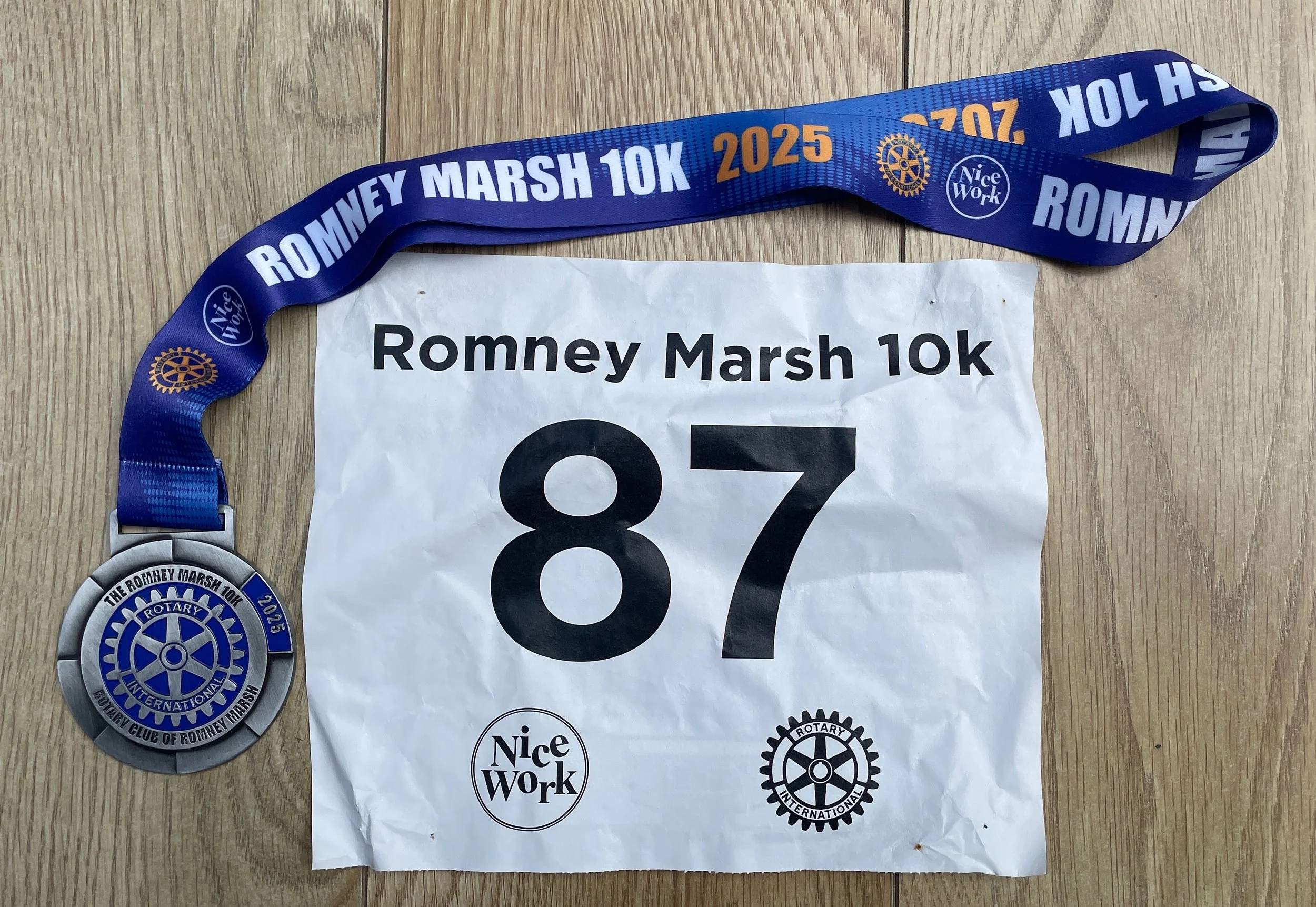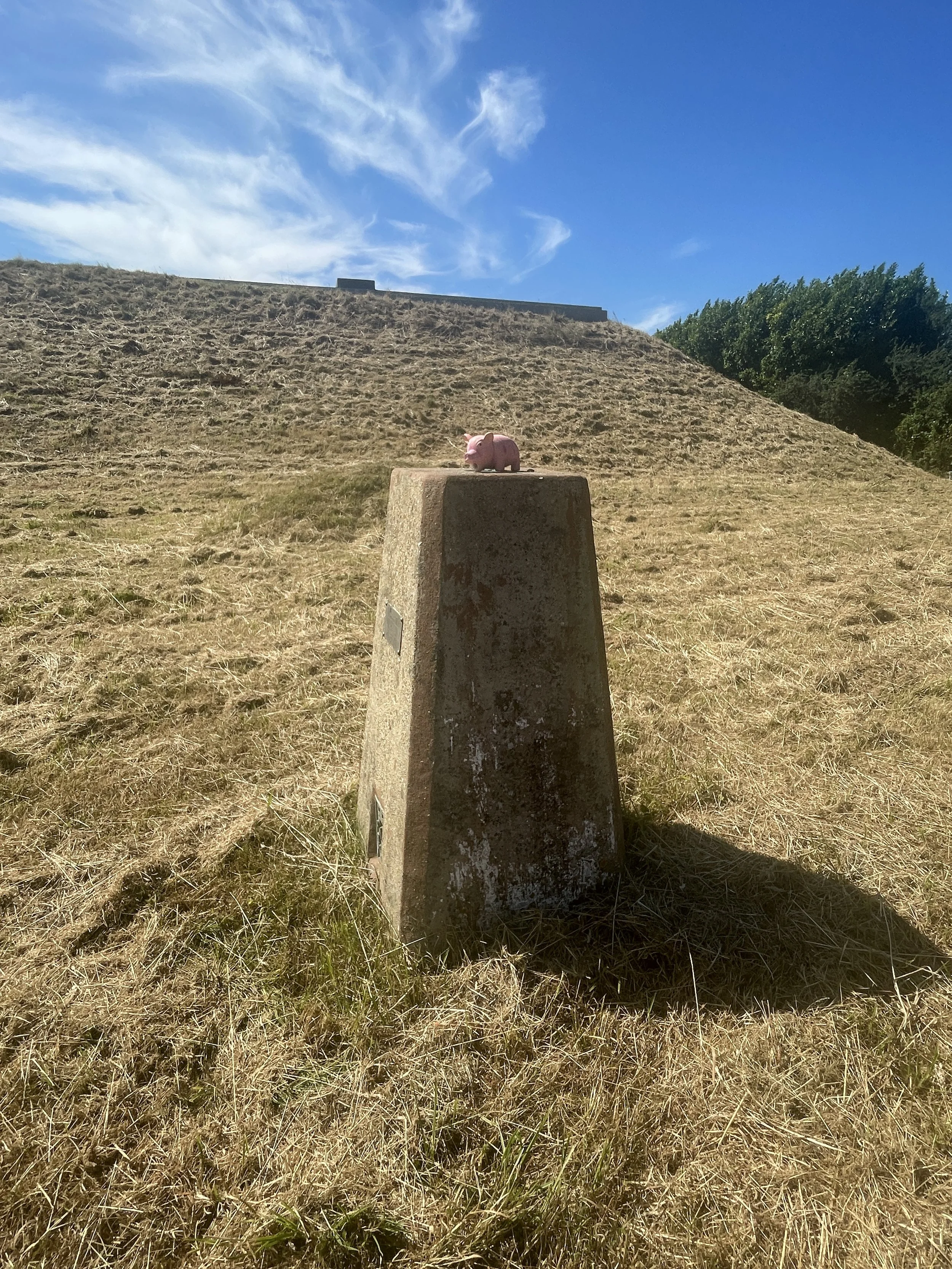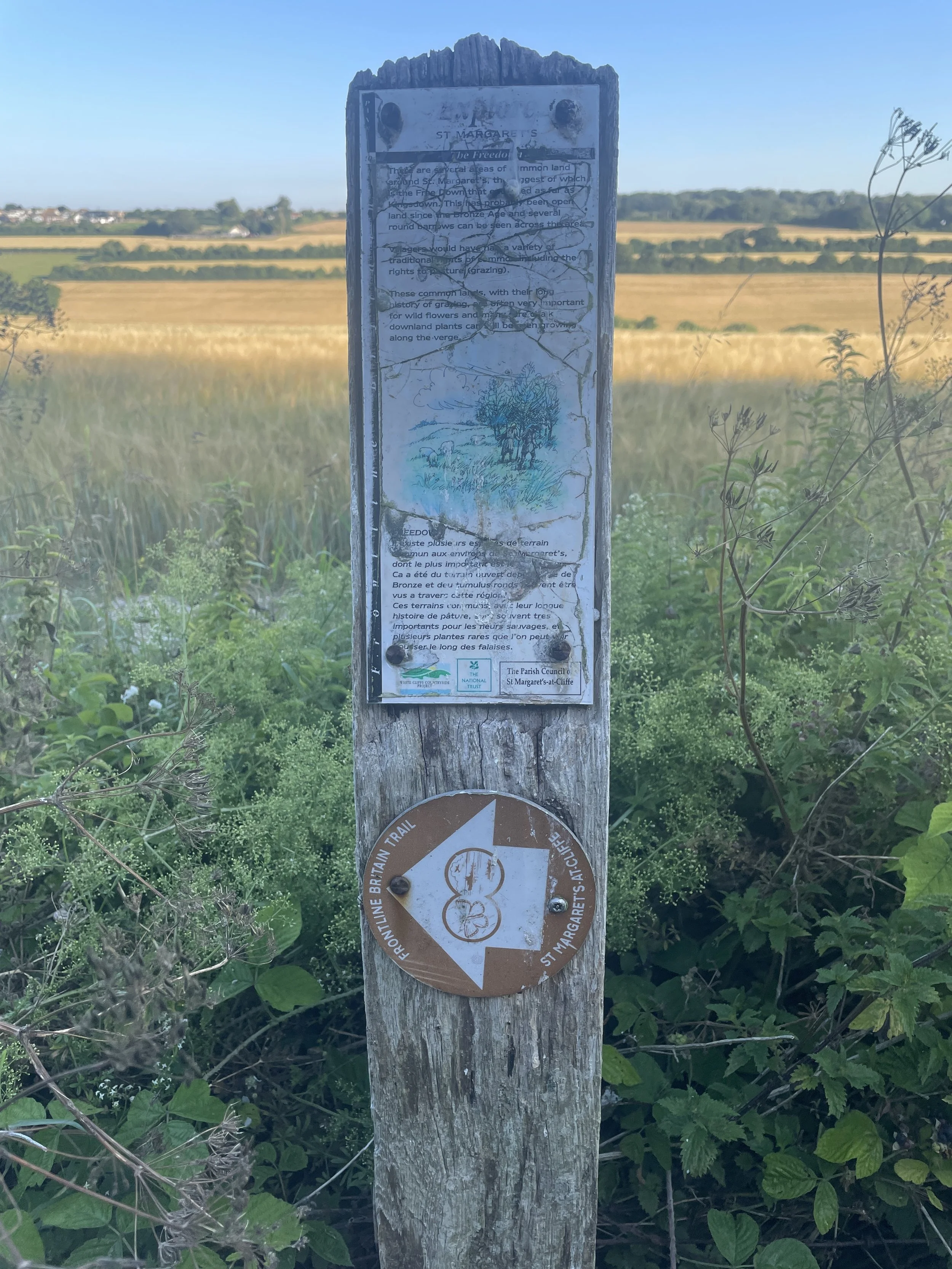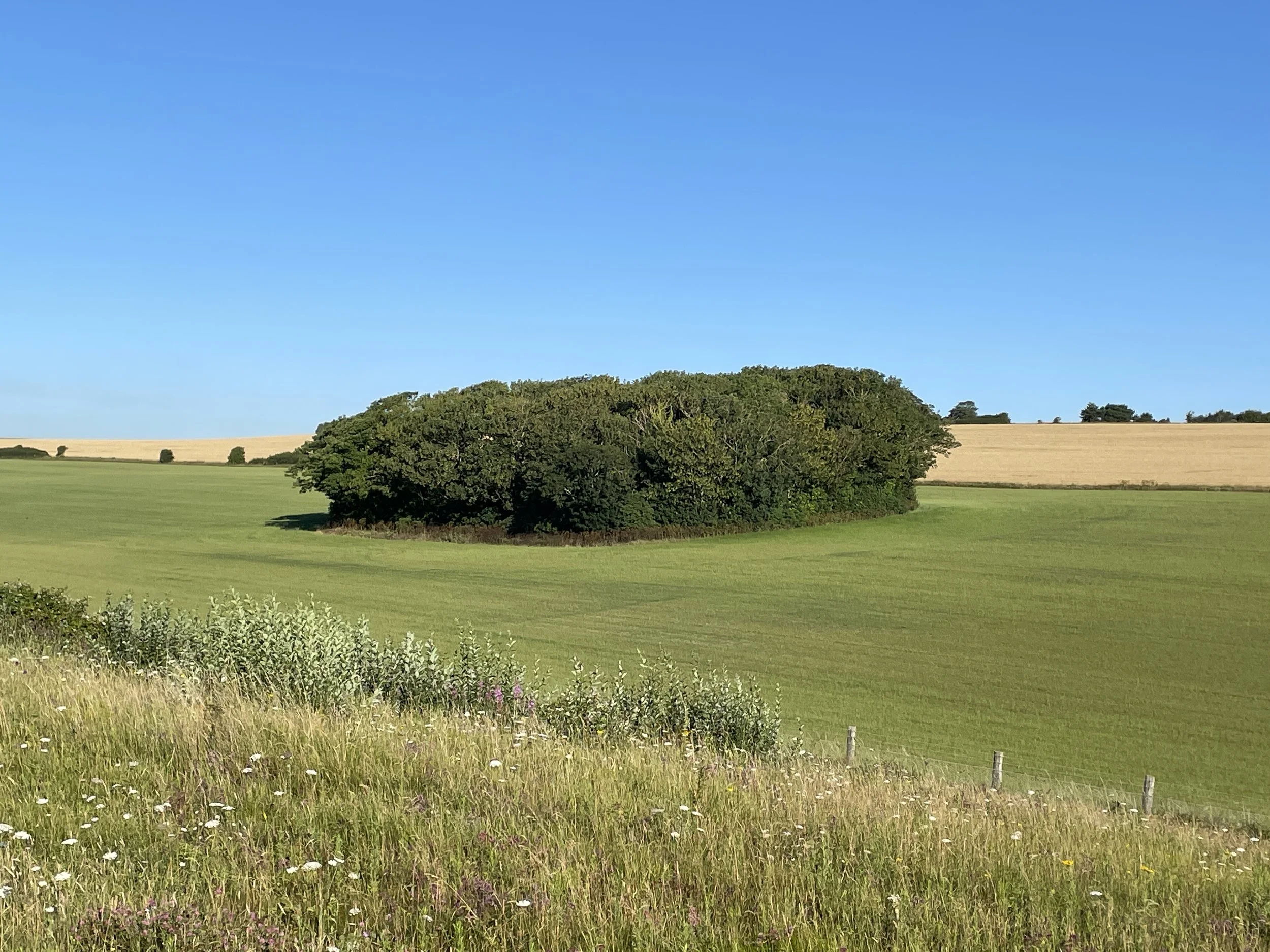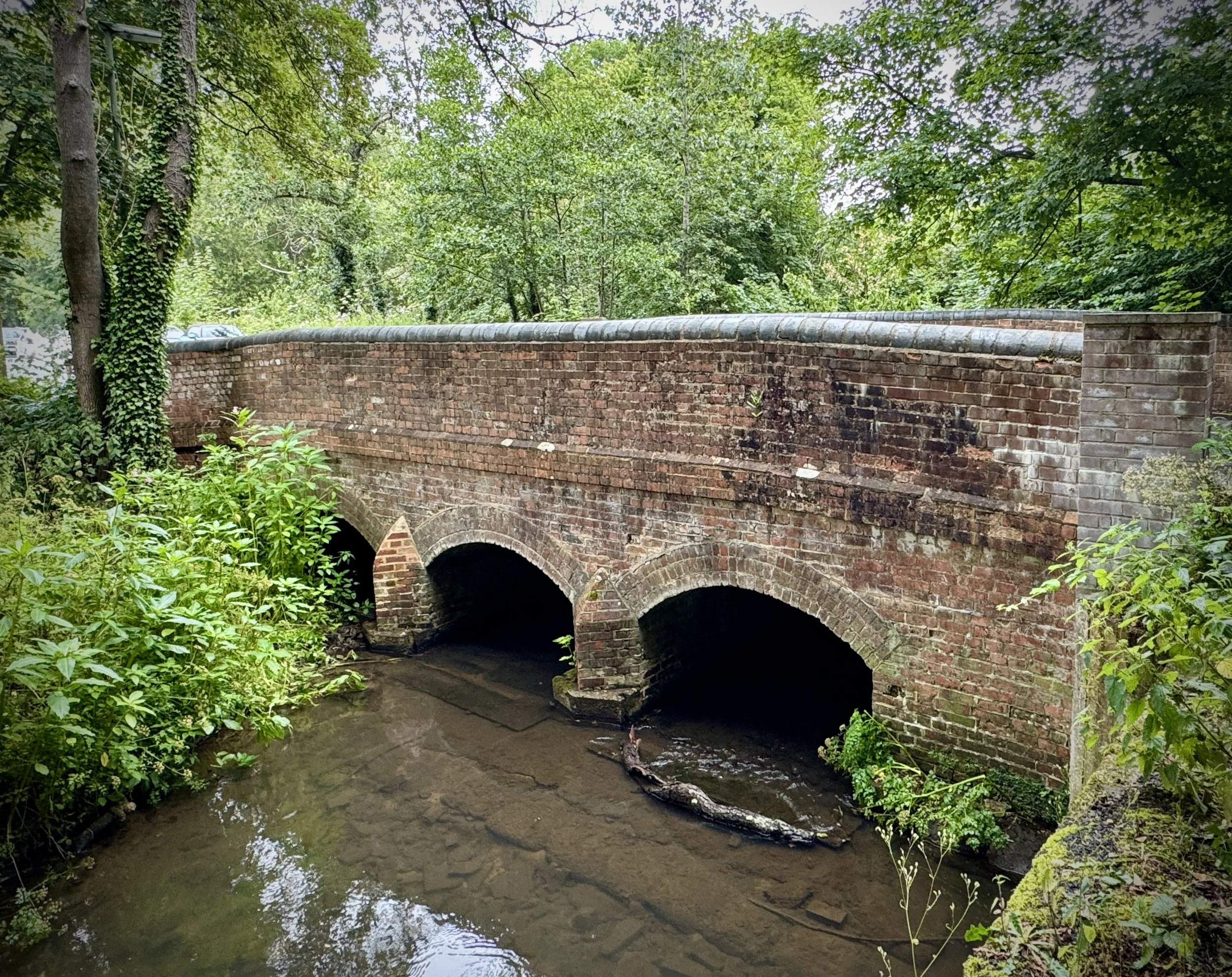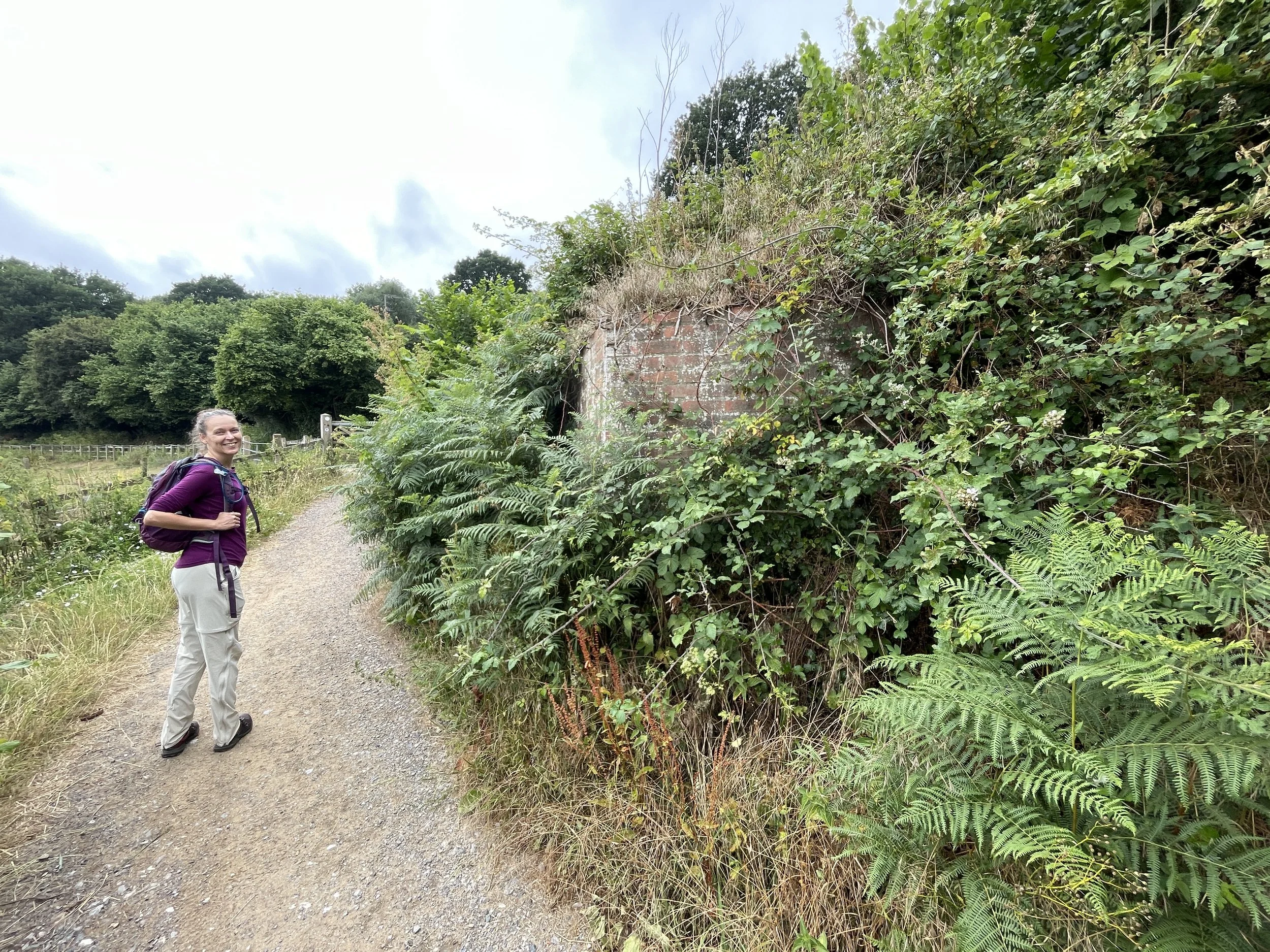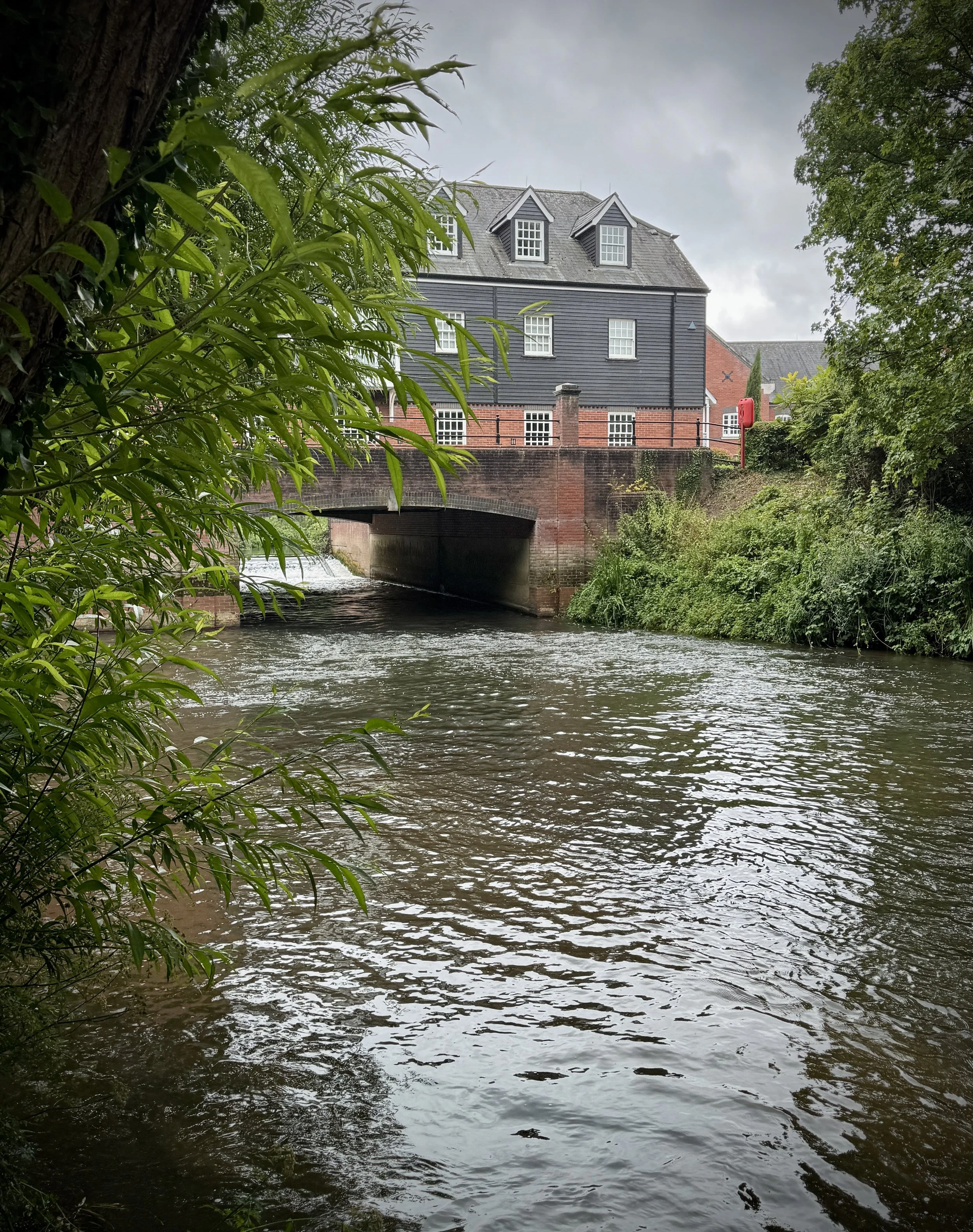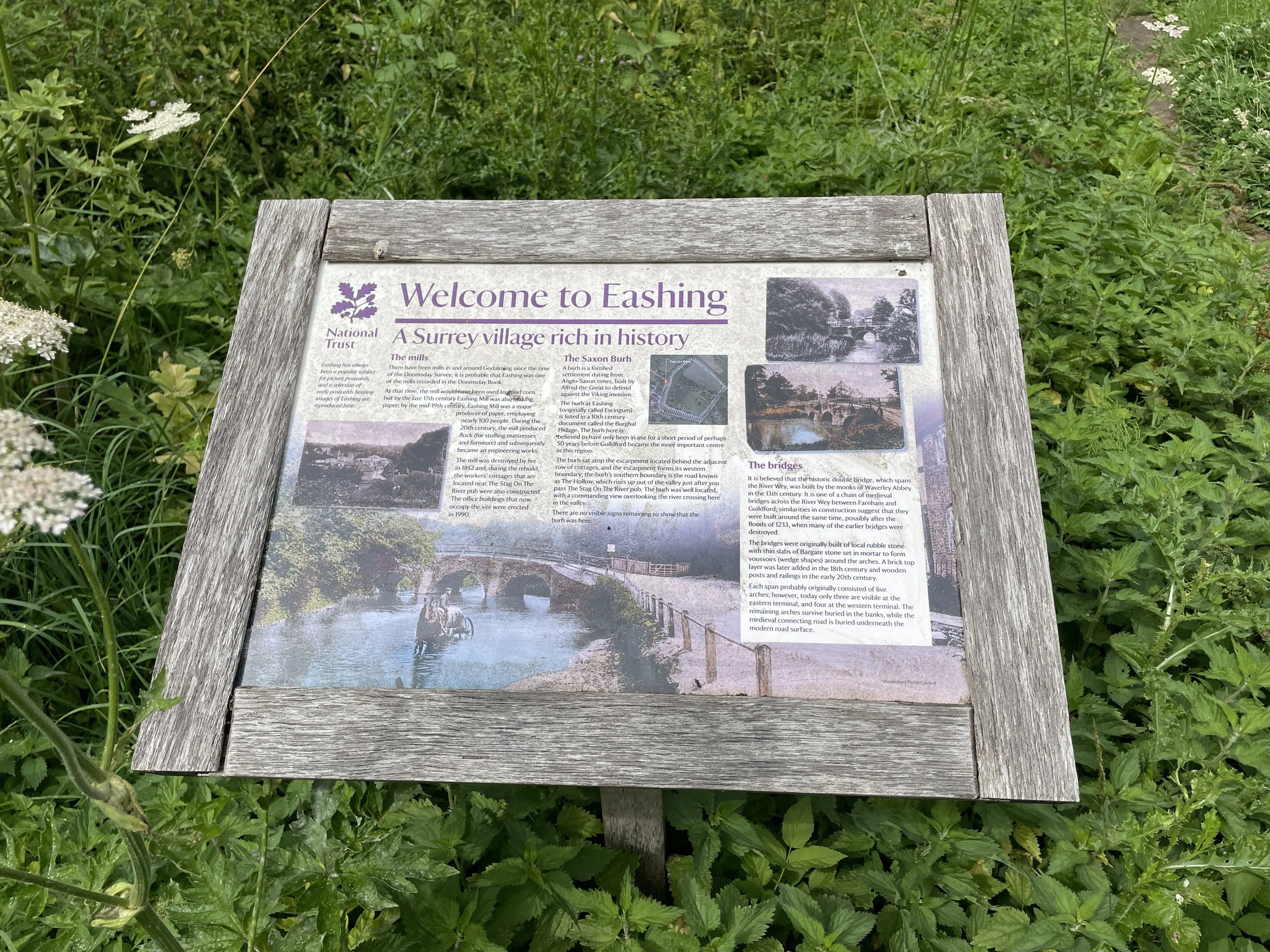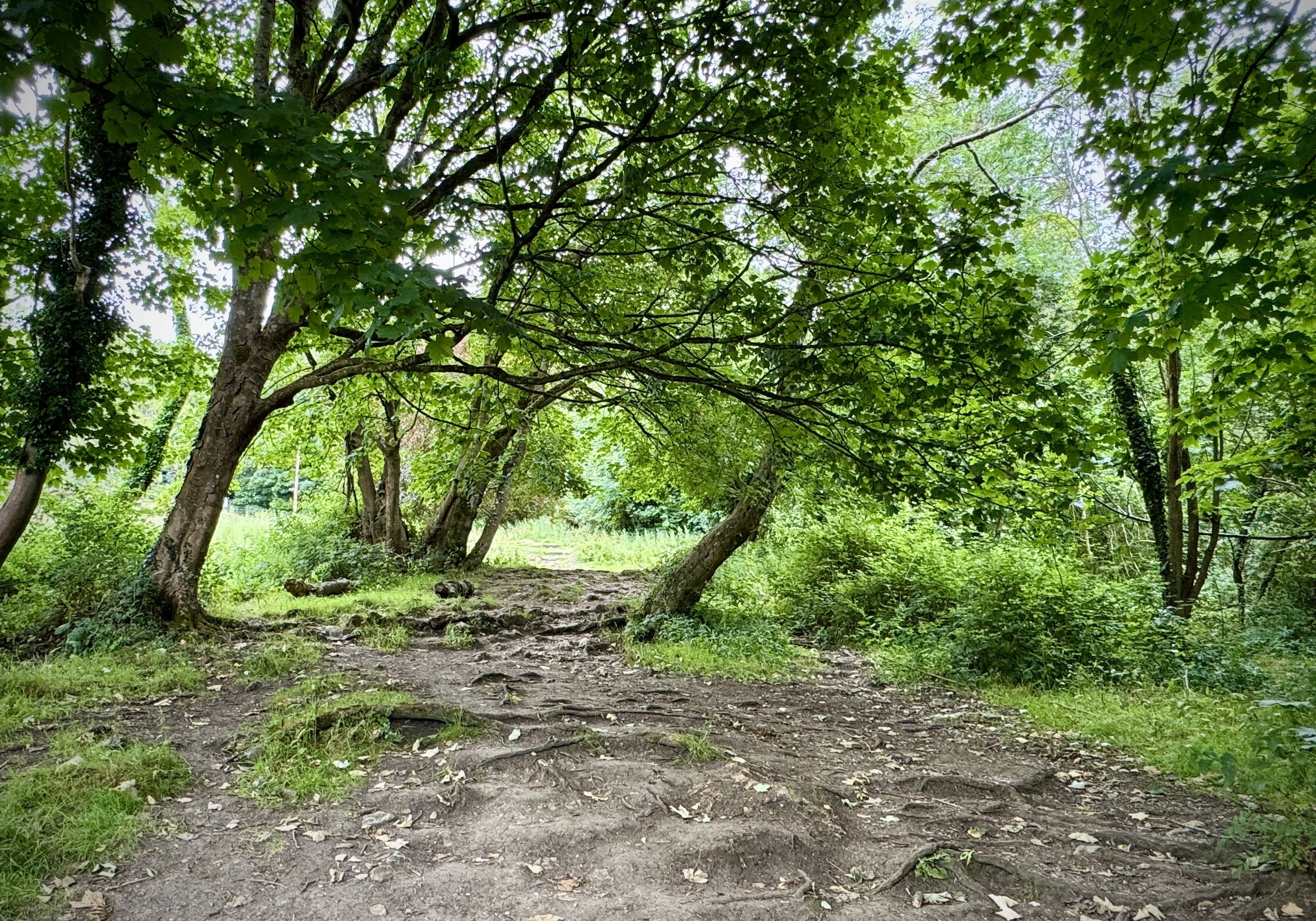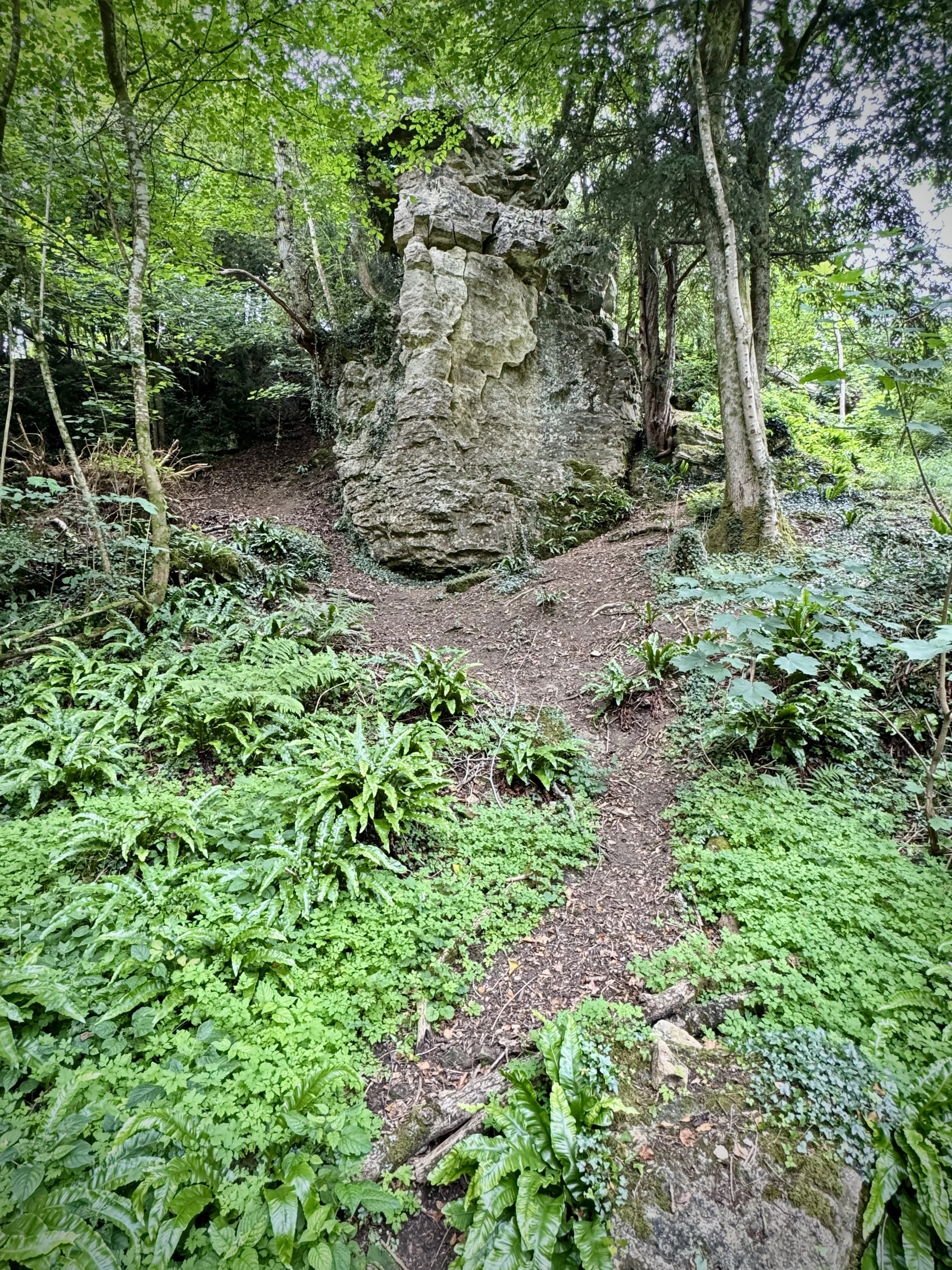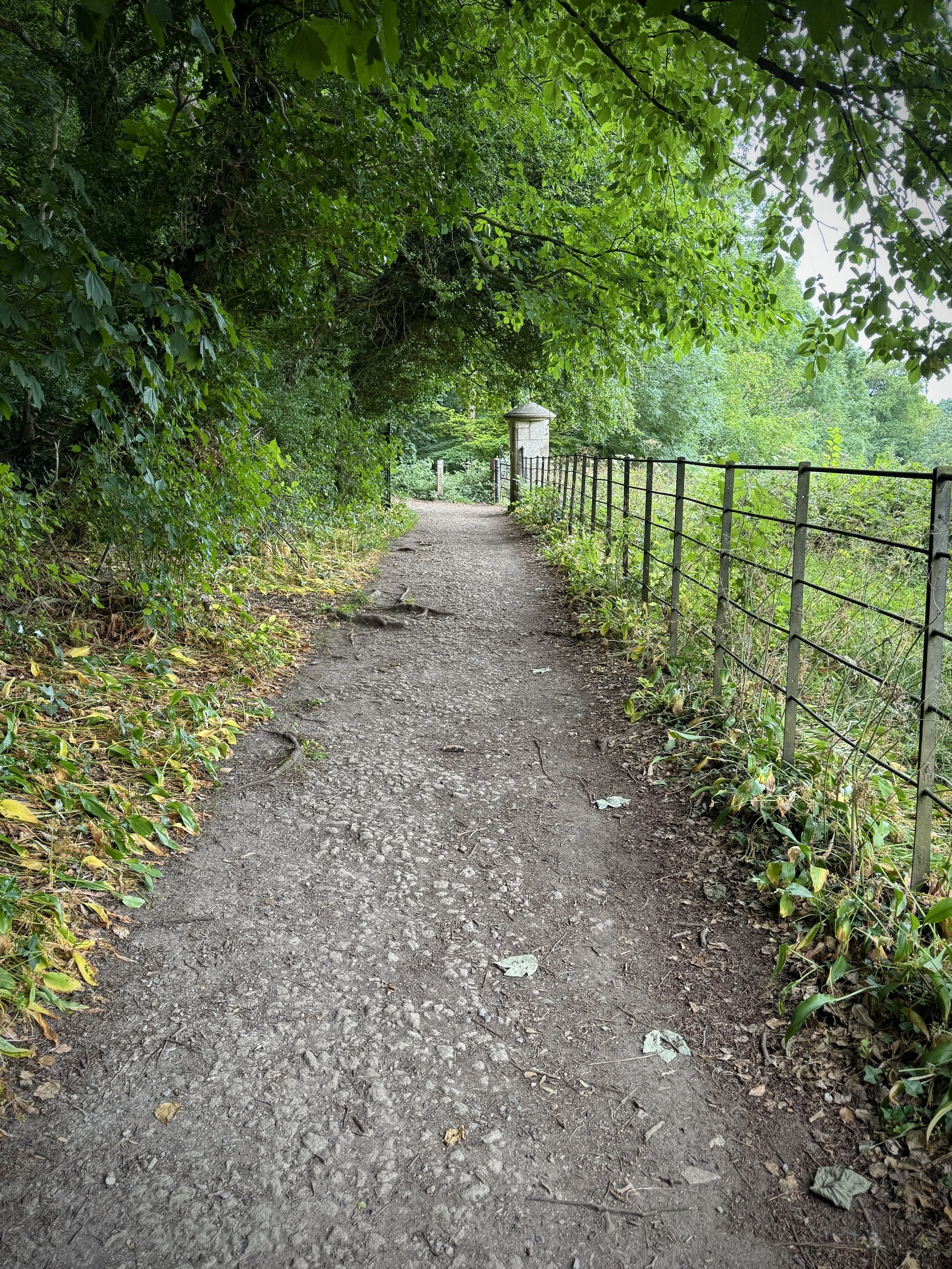When: July 13th 2025
Where: St. Martin's Field, New Romney, Kent
Organiser: Romney Marsh Rotary Club
Distance: 10 km
Elevation: +/- 24m
Course: 3 km arc out and back at start and end then a 4km loop near St Mary in the Marsh. Quiet country roads among wheat fields.
Other routes touched: None
Finish time: 57 minutes, 55 seconds
Significance: Highest point in the Lathe of Shepway
Elevation: 187m
Date “climbed”: 12th July 2025
Coordinates: 51°06'46.0"N 1°08'30.3"E
OS Trig Pillar: TP0449 - Paddlesworth
Map: Dover, Folkestone & Hythe Map | England Coast Path | Ordnance Survey | OS Explorer Map 138
Links: Wikipedia: (Lathe of Shepway, Paddlesworth), Wikishire: Lathe of Shepway
I visited the Paddlesworth Trig Pillar as a part of a mission to bag the High Points of the Kent Lathes, the historic sub-divisions of Kent. I couldn’t find an established list of the Lathe High Points so I worked them out based on Trigpointing.uk and Peakbagger logs. I’m pretty sure that Paddlesworth is the high point of the Lathe of Shepway but please let me know if you think that the high point is somewhere else.
This is a very quick drive-by bag. The pillar is in the grounds of a reservoir at the end of Fisher’s Lane in Paddlesworth. It’s private property but the pillar is very close to the gate. Easy to take a photo from a short distance or to hop over the gate to reach it.
View to Aycliffe and Dover Harbour from the descent from Farthingloe
Significance: Highest point in the Kent Lathe of St. Augustine
Elevation: 182m
Date “climbed”: July 12th 2025
Coordinates: 51°12'42.1"N 0°53'51.2"E
Route Start / End: On-street parking at junctions of St David’s Avenue and Old Folkestone Road, Aycliffe, Dover, CT17 9HJ, Kent
Route Distance: 1.8 km (1.1 miles)
Route Elevation Change: +/- 66m
GPX File: get via Buy Me a Coffee
Other routes touched (walk): none
OS Trig Pillar: TP3122 - Farthingloe
Map: Dover, Folkestone & Hythe Map | England Coast Path | Ordnance Survey | OS Explorer Map 138
Links: Wikipedia: Lathe of St Augustine, Wikishire: Lathe of St. Augustine, Dover Historian: Farthingloe
I visited the Farthingloe Trig Pillar as a part of a mission to bag the High Points of the Kent Lathes, the historic sub-divisions of Kent. I couldn’t find an established list of the Lathe High Points so I worked them out based on Trigpointing.uk and Peakbagger logs. I’m pretty sure that Farthingloe is the high point of the Lathe of St. Augustine but please let me know if you think that the high point is somewhere else.
This one can be a quick out-and-back if you know where to go. The area around the pillar is quite overgrown so be careful. Long trousers and secateurs are worth taking in the summer. If you’re driving there’s plenty of free on-street parking in Aycliffe.
From the corner of St. David’s Avenue and Old Folkestone Road take a path through a gate heading west then take the first footpath on the right to ascend the steep hill. Although the route up the the hill looks straight on the map you’ll need to navigate around and through bushes to get to the top. At the path junction take a left heading west.
The trig pillar is just off the path to the left. I missed it on the way out and ended up at the wheat field. The circle on the map below is where I ended up in some abandoned farm buildings in a thorny bush. It was an interesting accidental diversion but you don’t need to go that far.
The pillar is a rare English cylindrical one and the views from it, and the descent are well worth the scramble to it. Return to Aycliffe by the same route.
Start & Finish: Parking at Dover Patrol Memorial, Granville Road, St Margarets Bay, St Margaret's at Cliffe, Dover, CT15 6DS
Distance: 5.5 km (3.5 miles)
Elevation change: +/- 83m
GPX File: get via Buy Me a Coffee
Other routes touched (walk): Saxon Shore Way, England Coast Path, St Margaret’s Frontline Britain Trail
Other routes touched (cycle): NCN 1
OS Trig Pillar: TP4009 - Hope Farm
Pubs / Cafes on route: None
Map: Dover, Folkestone & Hythe Map | England Coast Path | Ordnance
Links: St Margaret's at Cliffe, Dover Patrol Memorial,
This is a short walk near St Margaret's at Cliffe in Kent that visits the most south-easterly OS Trig Pillar in the UK. If you’ve searched for or stumbled across this page then you probably already know what an OS Trig Pillar is. If you don’t then this article from the Ordnance Survey is a good place to start.
The walk starts at the Dover Patrol Memorial where there’s a small free car park. Walk in a south-westerly direction away from the Memorial and look out for a brown footpath sign indicating the St Margaret’s Frontline Britain Trail just before you reach the houses. Follow this path in a north-westerly direction until you reach The Droveway (road). Take a left onto The Droveway then take the footpath on the right that takes you to Kingsdown Road. Take a right onto Kingdown Road to follow it in a north-easterly direction for 1.1 km. The road quickly becomes a track which is part of the NCN 1 cycle route.
Leave the track at the path into the Bockhill Farm National Trust property and follow the left hand edge of the field to a path junction. When you reach some open scrubland cut across the to find the Trig Pillar on the golf-course side of the boundary fence. After the Trig Pillar follow the fence to the south-east then turn left to follow the boundary path between the golf course and the edge of the farm. Look back to see a good view of the Trig Pillar across the golf course. Continue in a north-easterly direction along the field'/golf-course boundary then take the path on the right that leads down to the coastal path. Take a right onto the coastal path to follow it all the way back to the Memorial.
Significance: Highest point in the Kent Lathe of Scray
Elevation: 182m
Date “climbed”: 11th July 2025
Coordinates: 51°12'42.1"N 0°53'51.2"E
Route Start / End: Kings Wood Car Park, Challock, Ashford TN25 4AR
Route Distance: 450m (0.3 miles)
Route Elevation Change: +/- 3m
GPX File: get via Buy Me a Coffee
Other routes touched (walk): N/A
OS Trig Pillar: TP4236 - Kingswood
Map: Ashford Map | Headcorn, Chilham and Wye | Ordnance Survey | OS Explorer Map 137
Links: Wikipedia: Lathe of Scray, Wikishire: Lathe of Scray, Forestry England: Kingswood
I visited the Kingswood Trig Pillar as a part of a mission to bag the High Points of the Kent Lathes, the historic sub-divisions of Kent. I couldn’t find an established list of the Lathe High Points so I worked them out based on Trigpointing.uk and Peakbagger logs. I’m pretty sure that Kingswood is the high point of the Lathe of Scray but please let me know if you think that the high point is somewhere else.
This one is an easy drive-by bag from the Kingswood Forestry Commission Car Park. Take a left onto White Hill road and follow it for approx 150m. Enter the woods on the south side of the road and follow a faint path in the woods to find the Trig Pillar. You’ll notice a sign opposite the car park entrance saying “Private Wood. Keep Out”. I assume that this also covers the location of the Trig Pillar but it’s a very quick out-and back from the road without crossing any fences.
Old Eashing Bridge
Start and Finish: Crown Court Car Park, 41 The Burys, Godalming, GU7 1HR
Alternative Start and Finish: Godalming Station, Godalming GU7 1EU
Distance: 8.2 km (5.1 miles)
Elevation Change: +/- 90m
GPX File: get via Buy Me a Coffee
Other Routes Touched (walk): The Fox Way, Salgassens Path
Other Routes Touched (cycle): Surrey Cycleway
Cafe / pubs on route: Several at the start and end at Godalming. Plus: The Stag on the River (just off route at 4.2 km in)
Map: Guildford & Farnham Map | Godalming & Farnborough | Ordnance Survey | OS Explorer Map 145
Links: Wey Navigation, River Wey, Godalming, Eashing, Eashing National Trust
This is the ninth and last of a series of short circular walks along the River Wey and the Wey Navigation canal in Surrey. The guidance below will help you navigate but don’t use it as a fully accurate turn-by-turn guide. Always take a map and/or a GPX route and prepare well for the weather and terrain.
This walk picks up where section 8 left off at Godalming Station. If you’re driving there’s large car parks either at the station or at the Crown Court in the town centre. If you’re starting from the station head north onto Westbrook Road and take the Fox Way in an easterly direction to Borough Road. If you’re starting from the Crown Court Car Park then follow the Fox way in a westerly direction from the north-western corner of the car park to reach Borough Road.
Follow the path on the left hand side of Borough Road in a northerly direction then cross under the railway bridge. You’ll soon cross a cross bridge over Hell Ditch, a series of drainage channels following the northern side of the Wey near the town. Take the first path on the left after the railway bridge to leave Borough Road and follow Salgassens Path parallel to Hell Ditch.
This westerly-heading part of the walk is a quiet, pleasant section running by or close to the Wey as it meanders away from the town. We were there on a dry day buy I could imagine it being quite boggy after rain. There were a few bits that had recently been cut back and would likely be overgrown early summer.
Around the 4km mark the path ends at the road through Lower Eashing, rejoining the Fox Way. Take a left to follow the road over the National Trust Old Eashing Bridges. Take a right after the bridge to visit The Stag on The River pub. As well as a good place to rest half-way, this is the end of the walkable route next to the River Wey.
For the return section retrace your steps back to Eashing Bridge and follow the Fox Way. You’ll keep to the southern bank of the river for 200 metres before zig-zagging in an easterly direction back towards Godalming. When you reach New Way at the 6.5 km mark you have a choice: either take a left to follow the Fox Way back to Godalming Station or, the slightly longer route taking a right onto New Way to follow the railway line to Ockford Road then following Grove Road to Godalming High Street. I recommend taking the slightly longer route via the High Street to explore the old market town.
Previous section (north): Walking the River Wey Part 8: Guildford to Godalming
Bathwick Meadows
Start & Finish: Cleveland Walk Bus Stop on Bathwick Hill, Bath BA2 6EP
Distance: 9.4 km (5.8 miles)
Elevation change: +/- 169m
GPX File: get via Buy Me a Coffee
Other routes touched (walk): National Trust Family Discovery Trail
Other routes touched (cycle): None
Pubs / Cafes on route: None
Map: Bristol & Bath Map | Keynsham & Marshfield | Ordnance Survey | OS Explorer Map 155
Links: Bath, National Trust Bath Skyline
The Bath Skyline Walk offers a captivating escape into nature, just a stone's throw from the historic city of Bath. This National Trust trail winds through a diverse tapestry of landscapes, from ancient woodlands with dappled sunlight to open meadows bursting with wildflowers. As you traverse the route, you'll be treated to ever-changing, panoramic vistas that showcase Bath's iconic Georgian architecture, the winding River Avon, and the serene rolling hills beyond, providing a unique and breathtaking perspective of this UNESCO World Heritage city.
A good place to start is the Cleveland Walk Bus Stop on Bathwick Hill. Many people come here for the spectacular view of the city from Bathwick Meadows without actually doing the walk. If you are doing the walk then I recommend starting here and taking a clockwise direction so that you get to see the Bath city panorama as you approach the end of the walk. If you’re up for making the route a little bit longer you could also walk to the start from Bath City Centre or Bath Spa station. If you’re arriving by car and don’t want to pay the high city centre parking charges there’s free on-street parking on or near Cleveland Walk or North Road.
This post was originally published as the Run Report for Brickfields parkrun, Bath for Saturday June 28th 2025
Back in 2014 when I got my 50th parkrun Milestone T-Shirt I imagined a time in the far future when I get my 500th. It seemed so far off it was like Science Fiction back then. Based on a rough calculation of completing an average of 45 parkruns per year I worked out that I could complete 500 before my 50th birthday.
That plan would have happened if it wasn’t for Covid thwarting 70 weeks of parkrun opportunities. As we entered 2025, my year of turning 50, I worked out that I would do my 500th run just 6 weeks after my birthday. It also nicely coincided with a planned weekend in Bath with friends.
Having already done Bath Skyline earlier in the year I planned to do either Shepton Mallet or Somerdale Pavilion. My excitement grew when I noticed a brand new event pop up at Brickfields Park. It would also link to another obsession of mine, Disused Railways. With that the venue for my 500th run was set. It also set in motion a series of coincidences that would unfold during the day.
On hearing that my 500th would be in Bath, Paul, a colleague and fellow parkrun tourist, decided to also plan a weekend in Bath with his partner around the event. Coincidence #1 was that their hotel was just round the corner from our B&B. We planned to walk to the event together but after a late arrival on the Friday and some complicated logistics we decided to drive separately and meet at the start.
I arrived at 08:30 with my wife and the friends that we were staying with. Shortly ahead of the First Timers Briefing, Paul texted me to say they had parked a mile away and were on their way. That checked out as we also parked a mile away at the stadium. By the time of the start I couldn't see him but figured that he must be at the back of the group and I’d see him on the out-and-back sections. I didn’t see him at all so I thought that something must have gone awry.
On finishing the run I checked my phone to see a message from him at 09:01 to say “it’s Bath Skyline, right?”. I replied with a Facepalm emoji. He’d travelled from Manchester for a weekend away to be at the wrong parkrun. It was all caused by something wrong with his 5k app not showing new events, so Bath Skyline was the only Bath parkrun event that showed up for him.
The situation also meant that I had two 500 Milestone pre-event shoutouts at two different events on the same day. Yet another coincidence was that Paul had unknowingly booked dinner at the same restaurant at the same time as us later in the day.
The final coincidence was having an accidental race to the finish line with Danny Norman, host of the parkrun With Me Now Podcast. I had met Danny once before but too long ago that I didn’t recognise him. What I did notice was a guy in a 500 milestone T-shirt just ahead of me as I closed in on the finish line. My wife was at the line waiting to video my 500th finish and I thought it would be fun to cross the line next to a runner in a 500 shirt. I sped up a bit to slightly overtake him to get both of us in the video. It was only later in the morning when a different friend of mine noticed Danny in the results 1 second behind me.
As well as all the funny coincidences, it was a lovely day for the run. It was a bright, warm summer day with a field of 282 runners and walkers. As a Disused Railway geek I loved the out-and-back on the old Somerset and Dorset Railway line.
First finisher was Harry McMurtrie coming in at 17:19 with a good spread of timings through to just over 1 hour. There were 174 First Timers to Brickfields Park and 32 PBs.
As always, a huge thanks to all of the volunteers who made the event possible. If you’ve not volunteered before or it’s been a while since you last did it, please consider signing up for one of your next events.
Thanks to everyone who helped make my 500th parkrun at Brickfields Park a fun and memorable event. A final special thanks goes to Neil Chapman who took me to my first parkrun on Boxing Day 2012. Saturday mornings have not been the same since.
More parkrun posts
parkruns are free, weekly, community 5k events all around the world. I started in December 2012 and have been obsessive about it ever since. See my parkrun Collection page for details.
Featured and popular parkrun posts:
Where the North Downs Way crosses the Wey Navigation
Start: Guildford Station, Guildford GU1 4UT
Finish: Godalming Station, Godalming GU7 1EU
Distance: 8.9 km (5.5 miles)
Elevation Change: +49m / - 42m. Net +7m
GPX File: get via Buy Me a Coffee
Other Routes Touched (walk): Wey Navigation Footpath, Wey-South Path, North Downs Way, Scholar’s Trail, Guildford and Shalford Disused Railways Walk, The Fox Way
Other Routes Touched (cycle): Surrey Cycleway
Cafe / pubs on route: Several at the start and end at Guildford and Godalming. Plus: The Ragged Robin (6.3 km in)
Map: Guildford & Farnham Map | Godalming & Farnborough | Ordnance Survey | OS Explorer Map 145
Links: Wey Navigation, River Wey, River Wey and Godalming Navigations (National Trust), Guildford, Godalming
This is the eighth of a series of short circular walks along the River Wey and the Wey Navigation canal in Surrey. The guidance below will help you navigate but don’t use it as a fully accurate turn-by-turn guide. Always take a map and/or a GPX route and prepare well for the weather and terrain.
Similar to Section 7 this is a station-to-station walk with a train connection between them. We parked near Guildford Station for the start of the walk and returned from Godalming Station at the end. There’s plenty of parking options at Guildford Station however we started 1 km away at Dapdune Wharf which has free parking for National Trust members.
Navigation is especially easy for this section as it follows the towpath on the north-western side of the canal for most of the way, crossing over to the southern side at Bridge Road Godalming. The only part to watch out for is at the start where the path across the islands at Millmead has been temporarily closed and you need to take a diversion of ~0.5km along Millbrook (A281), returning to the towpath after the Weyside pub.
Along the route you’ll pass the bridge where the North Downs Way crosses the canal with a very small beach next to it. We were there on a warm summer’s day and a lot of dogs were making the most of the beach for a dog party. Further down you’ll pass the disused section of the railway that once connected Shalford station to the mainline heading south. There’s also several WW2 Pill-boxes on the route guarding over the canal.
At Godalming you’ll reach the end of the navigable / canalised section. Beyond this the river Wey continues west towards Tilford where it splits with 2 sections leading to different sources. This is the final section of the Wey Navigation walks, but there’s one more walk that follows the river to Eashing.
Previous section (north): Walking the River Wey Part 7: Worpleston to Guildford
Next section (south): Walking the River Wey Part 9 - Godalming and Eashing
Ascent to Macdui with Loch Morlich in the background
Also Known As: Beinn Macduibh
Significance: Historic County Top for Aberdeenshire & Banffshire
Member of: UK County Tops, Scotland County/Unitary Authority High Points, Marilyns, Munros
Nearest Higher Neighbour: Ben Nevis
Elevation: 1,309m
Date climbed: June 13th 2025
Coordinates: 57° 4' 14'' N, 3° 40' 9'' W
Route Start & Finish: Cairngorm Mountain Upper Cas Car Park, Aviemore, PH22 1RB
Route Distance: 17.4 km (10.8 miles)
Route Elevation change: +/- 1.027m
Subsidiary tops on route: Ben Macdui - North Top (1,295m), Cairn Lochan (1,215m), Stob Coire an t-Sneachda (1,176m), Cairn Gorm - Fiacaill a' Choire Chois (1,141m), Cairn Gorm (1,244m)
GPX File: get via Buy Me a Coffee
Other routes touched (walk): Cairn Gorm Trail, Miadan Path
OS Trig Pillar: TP1286 - Ben Macdhui
Pubs / Cafes on route: Cairngorm Cafe at Cairngorm Mountain Base Station and at Ptarmigan Station
Map: Cairn Gorm & Aviemore: Sheet 403 (OS Explorer Map)
Links: Wikipedia: (Aberdeenshire / Banffshire / Ben Macdui), Peakbagger, Hillbagging
Ben Macdui is the Historic County Top for both Banffshire and Aberdeenshire and the 2nd highest of all of the UK County Tops. We bagged it in 2025 on our annual County Top weekend trip, along with the Historic County Tops of Nairnshire and Morayshire.
This was The Big One of our annual Scottish County Tops trips so far. Having worked our way through the southern Scottish summits it was now time to take on the 2nd highest summit in the UK. It was also the reason why we changed our trips from the end of September to mid-June. The Cairngorm plateau can be glorious in fine weather but dangerous in poor visibility. Moving to June would give us a highler chance of good weather and more hours of light to complete the trip. There’s several ways that you can approach Ben MacDui but we opted for a route that took in several other nearby peaks plus a trip on the Cairngorm Funicular.
Starting from the car park at the Cairngorm Mountain ski centre cross over the end of the ski runs to take the Cairn Gorm Trail in a south-westerly direction. After 4 km you’ll reach a split in the path where you’ll leave the Cairn Gorm Trail to keep on the Miadan Path heading south. You’ll reach the Trig Pillar at the summit of Ben Macdui after 8.5 km from the start.
At the summit we were grateful that we’d chosen to do the trip in June and that we had swapped from a rainy Saturday to a bright, dry Sunday. The views across the National Park were spectacular and made up for many cloudy ascents of UK high points in the past.
On a day of poor visibility the obvious route back would be to return the same way to the Base Station. As we had great weather and it was still early in the day we kept to our best-case plan and took the interesting route back, bagging more summits on the way. First up was Ben Macdui North-Top. This is just 700m from Ben Macdui summit and only 16m lower in elevation. From here you can decend carefully taking a north-westerly curve down the slope to rejoin the Miadan Path. Soon you’ll reach a split in the path where you’ll take the right-hand path heading north. At the 12 km mark leave the path to take a bearing up the slope to rejoin the Cairn Gorm Trail at the summit of Cairn Lochan.
After Cairn Lochan continue along the Cairn Gorm Trail in a north-easterly direction to the summit of Stob Coire an t-Sneachda then continue towards Cairn Gorm Mountain. Along the way you can take a minor diversion off the Trail to bag Fiacaill a' Choire Chois. After bagging Cairn Gorm, the 6th highest Munro, descend in a northerly direction to the Ptarmigan Station to visit the cafe, exhibition and the Funicular.
If you’re planning to take the Funicular check first that it’s running and don’t leave it too late in the day. We arrived an hour before the last train and were able to get onto one around 30 minutes after we arrived. If you miss the train or it’s not running you can also walk down via the Cairn Gorm Trail. Also note that you can only descend via the Funicular if you’ve been hiking as they don’t allow anyone out onto the hills if you’re using the train to ascend.
After the rain: descent of Carn a'Ghille Chearr
Significance: Historic County Top for Morayshire (formerly Elginshire)
Member of: UK County Tops, Scotland County/Unitary Authority High Points, Marilyns
Parent Peak:
Nearest Higher Neighbour: Creagan a' Chaise
Elevation: 710m
Date climbed: June 13th 2025
Coordinates: 57° 21' 4'' N, 3° 25' 53'' W
Route Start & Finish: Car park at Ballcorach off the B9136
Route Distance: 11.6 km (7.2 miles)
Route Elevation change: +/- 497m
Subsidiary tops on route: Carn Eachie (705m)
GPX File: get via Buy Me a Coffee
Other routes touched (walk): None
OS Trig Pillar: TP2604 - Cromdale
Pubs / Cafes on route: None
Map: OS Explorer OL61 Grantown-on-Spey & Hills of Cromdale
Links: Wikipedia: (Morayshire), Peakbagger, Hillbagging
Carn a'Ghille Chearr is the Historic County Top for Morayshire and the 33rd highest of all of the UK County Tops. We bagged it in 2025 on our annual County Top weekend trip, along with the Historic County Tops of Nairnshire, Aberdeenshire and Banffshire.
In our original plan we were going to do Ben Macdui on the Saturday of our weekend away but, on checking the weather, we moved it to the dryer Sunday and went for the shorter, easier walk of Carn a'Ghille Chearr instead. It turned out to be a good choice, but did mean that we hardly got any views. In Jonny Muir’s UK County Tops book he describes it as “a miserable trudge through sopping bog over grassy tussocks” on a miserable day. We had a miserable day and Jonny was 100% correct.
The start of the route is a small free car park at Ballcorach off the B9136. Before you start take a few minutes to walk down to the banks of the River Avon for a nice view of the river and the bridge that you will have just driven across. To start the walk, first head north keeping to the western side of the river. After ~200m take the footpath on the left heading towards the mountain.
The route is straightforward with just one path leading up to the Trig Pillar at the summit. The path is well defined for most of the way but loses itself in the bog near the point where is curves towards Carn Eachie. We were in drizzly cloud by then so we relied on the GPS to keep us on track. We had read that there’s remains of a crashed plane between Carn Eachie and the summit but we couldn’t find anything despite a bit of hunting. Maybe it would have been obvious on a clear day.
On the return to strayed off route a bit, taking a more direct route to the start, cutting off the big curve that we came up on.
Summit of Càrn Glas-choire
Significance: Historic County Top for Nairnshire
Member of: UK County Tops, Scotland County/Unitary Authority High Points, Marilyns, Grahams
Nearest Higher Neighbour: Geal-charn Mor
Elevation: 659m
Date climbed: June 13th 2025
Coordinates: 57° 20' 22'' N, 3° 50' 36'' W
Route Start & Finish: Parking spot 200m south of farm track to Aucherteang Cottage on the B9007.
Route Distance: 13.1 km (8.1 miles)
Route Elevation change: +/- 385m
Subsidiary tops on route: None
GPX File: get via Buy Me a Coffee
Other routes touched (walk): None
OS Trig Pillar: TP1956 - Carn Glas Choire
Pubs / Cafes on route: None
Map: Lochindorb, Grantown-on-Spey & Carrbridge Map | Caingorms National Park | Ordnance Survey | OS Explorer Map OL60
Links: Wikipedia: (Nairnshire), Peakbagger, Hillbagging
Càrn Glas-choire is the Historic County Top for Nairnshire and the 40th highest of all of the UK County Tops. We bagged it in 2025 on our annual County Top weekend trip, along with the Historic County Tops of Morayshire, Banffshire and Aberdeenshire.
We picked Càrn Glas-choire as the first of our weekend walks as it’s roughly 45 minutes from Inverness airport and on the way to Aviemore where we were staying. There’s not many options for parking but fortunately it’s not a popular mountain so it wasn’t a problem. We found a parking spot next to a gate a few minutes walk to the south of the route.
First find the track off the B9007 with the sign to Auchterteang Cottage and follow it in a north-easterly direction through the farm. The path soon crosses over Duthill Burn and continues to meander up the mountain to the trig point at the summit. It’s a well maintained path and navigation is simple. The only time that we needed to rely on our GPS was to check the return route down from the cloudy top.
We returned by the same route, completing the whole trek in just over 3 hours. After returning to the car we headed for a whisky at Glenlivet Distillery, a 10 minute drive away. It was a nice warm-up for the weekend but I don’t think this one will stand out in our memories of the full set of County Tops.
When: June 1st 2025
Where: Green Park, Reading, Berkshire
Organiser: Good Running Events
Distance: 10 km
Elevation: +/- 60m
Course: 3 km arc within Green Park and a 7 km loop of country roads either side of the M4.
Other routes touched: None
Finish time: 54 minutes, 52 seconds
Post 130 At Epsom Race Course
Start & Finish: Tattenham Corner Station, Epsom, KT18 5QD
Distance: 11.1 km (6.9 miles)
Elevation change: + / - 160 m
GPX File: get via Buy Me a Coffee
Other routes touched (walk): None
Other routes touched (cycle): NCN 22
London Coal Duty Posts: 125, 126, 127, 128, 129, 130, 131, (132), 133, 134, (135), 136
Pubs / Cafes on route: The Bell (just off route at 7.6 km), several in Tattenham Corner High Street
Map: Dorking, Box Hill & Reigate Map | Leatherhead & Caterham | Ordnance Survey | OS Explorer Map 146
Links: Coal Duty Posts, Tattenham Corner, Epsom Downs Race Course, Epsom Downs, Langley Vale Wood, Tadworth
Similar to the Banstead Heath Circular, this walk takes advantage of having several Coal Duty Posts in close proximity. On the 11 km walk through Epsom Downs and Langley Vale Wood you can visit posts 125 to 136. Note that post 135 is no longer visible as it’s in a private garden hidden by a large fence and bushes. Even if you’re not into bagging the Coal Posts, this is a very pleasant walk.
The route crosses the Epsom Downs Race Course on public rights of way which are occasionally closed during race events. Check before you go to make sure that the paths are open.
The start of the route is from Tattenham Corner Station where there’s also 2 car parks. From the station walk along Tattenham Crescent toward the race course then take a right onto Tattenham Corner Road heading north, The first Coal Post (132) is near the Tattenham Corner Pub. Take a left onto National Cycle Route (NCN) 22 heading in a south-westerly direction through the race course. Along this 2.2 km stretch you’ll pass posts 129, 128, 127 and 126 either on or just off the cycle route.
At Post 126 leave NCN 22 and take a right to follow the path through Langley Bottom Farm then take a left to the path that runs close to the southern edge of Langley Vale Road in a south-westerly direction. You’ll find post 125 near the junction of Langley Vale Road, Headley Road and Downs Road. Keep on the path running next to Downs Road then a left onto Headley Road to the entrance of the Langley Vale Wood Woodland Trust site.
The next 2.5 km meander through Langley Vale Wood. This was farmland purchased by the Woodland Trust in 2014 and is now one of four First World War Centenary Woods remembering those killed in the war. Its a beautiful place to walk though. Follow the paths until you reach Post 136 at the corner of Motts Hill Lane.
Take a left to follow Motts Hill Lane in a northerly direction but keep on the path when Motts Hill Lane curves to the right at (the hidden) Post 135. Keeping on the path you’ll pass Post 134 and, when the path meets Epsom Lane North, you can squeeze through the hedge for Post 133 on the eastern side of the road. Just after Post 133 you’ll see Post 130 on the opposite side of the race-course. Cross the track on the footpath to visit it. Cross back over to visit Post 131 on the small hill overlooking the race-course and then follow Royal Drive to return to Tattenham Corner Station.
The Coal Duty Posts
Rotten Row
The Shakespeare’s Way is a 235 km / 146 mile mile long-distance path connecting Shakespeare's birthplace in Stratford-upon-Avon with the Shakespeare's Globe (Theatre), Southwark, London. A 34km section of the path cuts through the Chiltern Hills National Landscape in a south-easterly direction. Our walks take in short sections of the Shakespeare’s Way and loop back to the start on other paths. The Shakespeare’s Way is reasonably well marked however you’ll need a map or GPX route to keep on track for the return sections of the loops. The guidance below will help but don’t use it as a fully accurate turn-by-turn guide.
Point to Point: Britwell Salome to The Grand Union Canal at Yiewsley
Start: Britwell Salome, Watlington, OX49 5LG
Finish: Grand Union Tow Path, Yiewsley, West Drayton, UB7 7XN
Distance: 59 km (36.7 miles)
Elevation change: + 665 / - 755m. Net +90m
GPX File: get via Buy Me a Coffee
Maps: See individual section posts linked below.
- Chiltern Hills West Map | Henley-on-Thames & Wallingford | Ordnance Survey | OS Explorer Map 171
Links: Shakespeare’s Way (LWDA), See individual section posts linked below for other links.
Walking The Shakespeare’s Way Chilterns Section in 12 Circular Routes
If you’re not up for an 59 km walk in one go, you can take in the Shakespeare’s way in 12 circular walks of between 6 and 13 km each. We chose this option, completing all 12 sections over a few years from 2020 to 2025. The advantage of this option is exploring more of the villages and side paths close to the route. After Route 12 you can follow the Beeches Way to reach Yiewsley and the end of the Chilterns Section of the Shakespeare’s Way.
Note that these walks take you through the Chilterns Hills National Landscape. See the Walking The Beeches Way post for the continuation from Cookham to Yiewsley
Each number refers to a circular walk below. Base map: Esri Topo via RideWithGPS
Part 1: Britwell Salome and Lower Warren
Distance: 7.8 km (4.8 miles)
Elevation change: +/- 123m
Shakespeare’s Way section covered: Britwell Salome to The Ridgeway: 2.2 km
Part 2: Swyncombe and The North
Distance: 8.1 km (5 miles)
Elevation change: +/- 176m
Shakespeare’s Way section covered: The Ridgeway to Cookley Green: 3.8 km
Part 3: Swyncombe and Park Corner
Distance: 9.9 km (6.2 miles)
Elevation change: +/- 199m
Shakespeare’s Way section covered: Cookley Green to The Chiltern Way near Maidensgrove: 2.1 km
Part 4: Nettlebed, Park Corner and Maidensgrove
Distance: 8.5 km (5.3 miles)
Elevation change: +/- 159m
Shakespeare’s Way section covered: The Chiltern Way near Maidensgrove to Park Lane: 1.2 km
Part 5: Russell's Water, Pishill and Maidensgrove
Distance: 9.2 km (5.7 miles)
Elevation change: +/- 166m
Shakespeare’s Way section covered: Maidensgrove Common to farm at south Maidensgrove: 1.32 km
Part 6: Stonor and Turville Heath
Distance: 10 km (6.2 miles)
Elevation change: +/- 208m
Shakespeare’s Way section covered: Farm at south of Maidensgrove to Southend: 5.9 km
Distance: 12.3 km (7.6 miles)
Elevation change: +/- 216m
Shakespeare’s Way section covered: Southend to Hambleden: 5.4 km
Part 8: North-east Hambleden Circular
Distance: 9.7 km (6 miles)
Elevation change: +/- 145m
Shakespeare’s Way section covered: Hamble Brook to Rogues Plantation: 2.9 km
Part 9: Bovingdon Green and Shillingridge Wood
Distance: 10.9 km (6.8 miles)
Elevation change: +/- 152m
Shakespeare’s Way section covered: Rogues Plantation to Pullingshill Wood: 2.5 km
Part 10: Marlow and Harleyford
Distance: 10.2 km (6.3 miles)
Elevation change: +/- 94m
Shakespeare’s Way section covered: Pullingshill Wood to The Thames Path at Marlow: 3.4 km
Distance: 11.4 km (7 miles)
Elevation change: + / - 65m
Shakespeare’s Way section covered: The Thames Path at Marlow to Bourne End Rail Bridge: 3.4 km
Part 12: Bourne End, Cookham and Wooburn
Distance: 8.2 km (5.1 miles)
Elevation change: +/- 83m
Shakespeare’s Way section covered: Bourne End Rail Bridge to Broad Lane, Widmoor: 3.9 km
View to Turville and Fingest from the edge of Great Wood
Start & Finish: Car park next to the Stag and Huntsman, Hambleden, Henley-on-Thames RG9 6RP
Distance: 12.3 km (7.6 miles)
Elevation change: +/- 216m
Shakespeare’s Way section covered: Southend to Hambleden: 5.4 km
GPX File: get via Buy Me a Coffee
Other routes touched (walk): The Chiltern Way, Shakespeare’s Way
Other routes touched (cycle): Chiltern Cycleway
Pubs / Cafes on route: The Stag and Huntsman at the start and finish, The Frog at Skirmett (closed for refurbishment when we passed)
Map: OS Explorer 171: Chiltern Hills West, Henley-on-Thames and Wallingford
Links: Hambleden, Skirmett, Southend
The Shakespeare’s Way is a 235 km / 146 mile mile long-distance path connecting Shakespeare's birthplace in Stratford-upon-Avon with the Shakespeare's Globe (Theatre), Southwark, London. A 34km section of the path cuts through the Chiltern Hills National Landscape in a south-easterly direction. Our walks take in short sections of the Shakespeare’s Way and loop back to the start on other paths. The Shakespeare’s Way is reasonably well marked however you’ll need a map or GPX route to keep on track for the return sections of the loops. The guidance below will help but don’t use it as a fully accurate turn-by-turn guide.
For this walk we parked at the car park next to the Stag and Huntsman in Hambleden and took Pheasant’s Hill (lane) in a northerly direction out of the village. After approximately 300m take a footpath on the left to join the Chiltern Way and continue following it north until Shogmore Lane. Take a left then a right onto Fingest Lane. Shortly after The Frog pub in Skirmett, take the first footpath on the left and follow it until it rejoins the Chiltern Way. Take a left onto the Chiltern Way and follow it in a south-westerly direction to Drover’s Lane in Southend.
Take a right onto Drovers Lane, continuing on the Chiltern Way to connect with the Shakespeare’s Way. Take the first footpath on the left to follow both the Chiltern Way and Shakespeare’s Way back to the start in Hambleden.
Shakespeare’s Way previous section (west): Stonor and Turville Heath
Shakespeare’s Way next section (east): North-East Hambleden Circular
Early morning start in Hastings
This was a 2-day cycle adventure continuing our occasional crawl around the south-coast of England, 1 weekend at a time. We picked up where we left off the previous summer at Dover Waterfront and headed towards Brighton. As well as being well-spaced for a 50(ish) mile a day trip, the towns were also good for trains to and from London. Our main consideration was that the outbound train from London Victoria to Dover Priory has to be after 19:00 to avoid Friday evening rush-hour. It got us into Dover after dark but it was only a 10 minute cycle to the Dover Premier Inn where we were staying. There were no restrictions on the return trip from Brighton to London Victoria on the Friday.
Day 1: Dover to Hastings
Start: Dover Priory Station, Priory Station Approach Road, Dover CT17 9SB
Finish: Hastings Pier, 1-10 White Rock, Hastings, TN34 1JY
Distance: 97.4 km (54 miles)
Elevation change: + 602m / -609m (Net -7)
GPX File: get via Buy Me a Coffee
Other routes touched (walk): Saxon Shore Way, North Downs Way, King Charles III England Coast Path, High Weald Landscape Trail, 1066 Country Walk
Other routes touched (cycle): NCN 1, 2, 17, Cantii Way
Pubs / Cafes on route: Lots, but we stopped at Pedaler on the Port, Dover (1.5 km in), The Star, St Mary in The Marsh (40 kmi in), Brew at 32, Lydd (51 km in), The Lookout, Rye (66 km in)
OS Trig Pillar: TP4139 - Jurys Gap
Maps:
- Dover, Folkestone & Hythe Map | England Coast Path | Ordnance Survey | OS Explorer Map 138
- Romney Marsh, Rye & Winchelsea Map | Tenterden & New Romney | Ordnance Survey | OS Explorer Map 125
- Hastings & Bexhill Map | Battle & Robertsbridge | Ordnance Survey | OS Explorer Map 124
Links: Dover, Folkestone, Abbots Cliff Sound Mirror, Hythe, Royal Military Canal, Romney Marsh, St Mary In The Marsh, Lydd, Camber Sands, Rye, Whichelsea, Hastings
Our trip started at 10:30 on the Saturday after Dover Waterfront parkrun and a slow breakfast at the Pedaler on the Port cycle cafe. The 87 km route was mostly flat but bookended by steep climbs at the start and end of the day. The early climb came right after Dover town as the NCN 2 ascends Shakespeare Cliff to Capel-le-Ferne before a steep descent into Folkestone. Watch out for the Sound Mirror next to the Millennium Milepost at 8 km which gives you a good excuse for a rest around half-way through the climb.
The first part of the flat section under Radnor Cliff in Folkestone and along the Royal Military Canal is a highlight of the route. We bypassed Hythe town but, in hindsight, we would have stopped there for some food as pubs and cafes are few and far between in the marshland west of Hythe. By the time we reached St Mary In The Marsh at 40km we more than ready for a rest in The Star pub. As it happened we were too late for lunch and too early for dinner so, after a short rest, we pressed onto Lydd to have a longer rest and some good food in the cycle-friendly Brew at 32.
After Lydd it’s only 6 km back to the coast at Jury’s Gap, although the strong wind in our face made it feel like 20 km. After another pub stop in Rye we pressed on towards Hastings via the steep climb at Fairlight. After 80 km of wind I had no interest in trying to keep in the saddle and decided to push the bike up most of the hill. The steep down into Hastings was the reward, as was the warm meal and early night ahead of day 2.
Day 2: Hastings to Brighton
Start: Hastings Pier, 1-10 White Rock, Hastings, TN34 1JY
Finish: Brighton Station, Queens Road, Brighton and Hove, Brighton, BN1 3XP
Distance: 72 km (44.7 miles)
Elevation change: +507m / -475m (Net +32m)
GPX File: get via Buy Me a Coffee
Other routes touched (walk): Motoring Heritage Trail, 1066 Country Walk, Wealdway, South Downs Way, Vanguard Way, Sussex Ouse Valley Way, Newhaven-Brighton Clifftop Path, Greenwich Meridian Trail
Other routes touched (cycle): NCN 2, 21, 90, Cuckoo Trail, Prime Meridan Cycle Route
Pubs / Cafes on route: Lots, but we stopped at Pevensey Starbucks (17.5 km in), Arlington Tea Garden (31.5 km in), The Ark, Newhaven (54.3 km in) and a chip shop near the beach in Brighton.
Maps:
- Hastings & Bexhill Map | Battle & Robertsbridge | Ordnance Survey | OS Explorer Map 124
- Eastbourne & Beachy Head Map | Newhaven, Seaford, Hailsham & Heathfield | Ordnance Survey | OS Explorer Map OL25
- Brighton & Hove Map | Lewes & Burgess Hill | Ordnance Survey | OS Explorer Map OL11
Links: Hastings, Bexhill-on-Sea, Pevensey, Cuckoo Trail, South Downs National Park, Alfriston, Seaford, Newhaven, Peacehaven, Rottingdean, Brighton
With no parkrun to work around we set off early along the Hastings to Bexford seafront with the aim of finding breakfast around 15km in. After passing several sea-side places that weren’t quiet open we settled for a Starbucks next to a petrol station in Pevensey. Not the nice coastal stop like we found in Walmer on the previous trip but it did the job.
Our original plan for this second day was to come off the NCN s at Pevensey, sticking to the coast through to Eastbourne then crossing the South Downs through Jevington. In the end we decided to stick to the NCN 2 through Polegate, Arlington and Alfriston. Although it takes a wide path away from the coast, it’s an interesting route through pretty villages.
After the South Downs section the NCN 2 took us back to the coast at Seaford. We were on familiar territory having visited Peacehaven, Rottingdean and Brighton on previous cycle trips.
Our final section took us along the coast to Brighton Pier with a quick stop near the beach for chips before heading north to the station to get the train back to London. The next section will likely be in 2026 with a return to Brighton for the next section to Poole.
The Full 2-Day Route
Day 1 in red, day 2 in blue
The Millennium Mileposts
Dotting the UK's National Cycle Network are over 1,000 unique markers known as the Millennium Mileposts. Unveiled in 2000, these cast-iron sculptures are more than just waymarkers. Designed by four artists, one from each nation of the UK, they celebrate the diversity of the cycling routes. These artistic mileposts come in various shapes and can be found in both bustling towns and scenic landscapes, adding a touch of artistic charm to a cycling adventure.
Here’s the 26 Mileposts that I spotted on the 2 day cycle trip. The first 22 were on Day 1 and the final 4 were on day 2.
When: May 18th 2025
Where: Chiltern Valley Winery & Brewery, Old Luxters, Henley-on-Thames, RG9 6JW
Organiser: Racing Line Running
Distance: 10 km
Elevation: +/- 167m
Course: 8 km loop of farms and woodland to the west of the Winery 7 Brewery with a 1 km out-and-back from the start/finish. Mostly farm track, woodland paths. Hilly
Other routes touched: Chiltern Way, Shakespeare’s Way
Finish time: 1 hour, 1 minute, 57 seconds
Ascent of Latterbarrow
When: May 10th 2025
Start and Finish: Low Cunsey Farm, Cunsey, Far Sawrey, Ambleside, LA22 0LU
Organiser: The Lap
Distance: 77km (47 miles)
Elevation change: +/- 2681m
GPX File: get via Buy Me a Coffee
Other routes touched (walk): Windermere Shore Footpath, Windermere West Shore, Dales Way, West Windermere Way
Other routes touched (cycle): NCN 6, 637. Lakes and Dales Loop
Other routes touched (run): Rothay Park parkrun
Summits: Latterbarrow, Loughrigg Fell, Wansfell Pike, Wansfell, Baystones, Orrest Head, Brant Fell, Gummer’s How
OS Trig Pillars: TP4549 - Loughrigg Fell, TP3536 - Gummers How
Map: The English Lakes: South-Eastern Area Map | Windermere, Kendal & Silverdale | Ordnance Survey | OS Explorer Map OL7
Finish time: 14 hours, 51 minutes, 24 seconds
Links: Lake Windermere, Graythwaite Estate, Far Sawrey, Skelwith Bridge, Ambleside, Troutbeck, Windermere (Town), Newby Bridge, Finsthwaite
This was my 14th Ultra and my 5th with my friend Mark. It was also my first big Ultra since the 100k Race To The Castle in 2021. Since then I’d had a few years of local 50k Ultras, waiting for another big one to excite me. After another friend had completed The Lap the previous year and loved it, I signed up straight away.
The Lap is a 75km circuit of Windermere, England’s largest lake. It takes a scenic, hilly route away from the lake with some tough climbs paid back by some great views. With the climbs, I found it hard to estimate what my finish time would be so I decided that finishing would be good enough and coming in before dark would be amazing.
As we arrived at the basecamp for the 06:00 start, the sun was coming up over the hills to the east of the lake. As usual at the start-line, I reminded myself not to get over excited and start too quickly. I need not have worried as the narrow country lanes and single-track through woods kept everyone at a slow, often walking, pace.
After the first feed station at Far Sawtry the pack was more spread out and we could speed up. Latterbarrow was the first climb at 11 km with a short steep climb up to the monument then an equally steep down. Shortly after the descent I saw road signs to Ambleside and decided that we were making very good time and would be there by our target of 09:30. I was wrong. I had forgotten that the route veers away from the lake at its north-west corner and climbs Loughrigg Fell before descending to Ambleside. It was at the second feed station at Skelwith that I realised we were actually an hour behind plan. It was also now getting hot and we still had the 2 big climbs to do. The new plan was “forget the plan”.
The northern section of the route has the 3 big climbs, Loughrigg Fell at 335m elevation and Wansfell at 487m. By Lake District standards, they’re both easy fells to walk but on an Ultra on a hot day they were killers. By the time we were down from Wansfell at the Troutbeck half-way feed-station, most of my running ability was gone.
Mark and I stayed mostly together until Gummers How, the final climb at 57 km. Mark is faster than I am so I generally lose him by the half way point. I often gain a bit of time at feed-stations as I don’t like to stop for long which gives me a bit of distance before Mark catches up with me again. Mark did a great job of encouraging me to run a few extra times rather than speed walk. That probably shaved up to 2 minutes off my total time.
My low-point of the route was a long stretch after Windermere of very similar-looking plantation and not many people around. Mark and I re-connected for the ascent of Gummer’s How. By the time we met Timea, our support crew for the day, we were both a bit tired and grumpy. I was still recovering from a cold and any running was now giving me a headache. Timea saved us with a pasty and some painkillers and we were back on the route.
Timea met us several times on the early evening southern section of the route greatly helping my motivation. After Newby Bridge the route turned back to the north for the final 10 km to the finish line. Although behind my “optimistic” plan, I had some new energy and felt that I could reach the finish before dark. I crossed the finish line at 20:51, well before dark and under 15 hours. Mark very kindly finished 18 minutes ahead of me so that he could be ready to video my finish.
It was in the top 3 most difficult Ultras that I’ve done but also in the top 3 most enjoyable.
Snaefell Station and Cafe with the summit marked by the transmitter on the right
Also known as: Sniaull (Manx). Snaefell comes from old Norse, meaning Snow Mountain or snaufjell - “area above the tree line”.
Significance: Country and Island High Point for the Isle of Man
Member of: Marilyn, Hardy, Island High Points, European Country High Points
Nearest Higher Neighbour: Iron Cragg (Cumbria, England)
Elevation: 621m
Date climbed: May 3rd 2024
Coordinates: 54° 15' 47'' N, 4° 27' 42'' W
Route Start: Snaefell Mountain Railway - Summit Station
Route Finish: Manx Electric Railway - Laxey Station.
Route Distance: 8.2 km (5.1 miles)
Route Elevation change: +29m / - 593m. Net - 564m
Subsidiary tops on route: None
GPX File: get via Buy Me a Coffee
Other routes touched (walk): None
Other routes touched (walk): Isle of Man Cycle Route 6
OS Trig Pillar: TP6035 - Snaefell
Pubs / Cafes on route: Snaefell Summit Restaurant & Café
Map: Isle of Man Map | Port St Mary, Castletown & Ramsey | Ordnance Survey | OS Landranger Map 95
Guidebook: Walking on the Isle of Man: 40 walks exploring the entire island (Cicerone)
Links: Wikipedia: (Isle of Man / Snaefell, Laxey, Snaefell Mountain Railway, Snaefell Mine), Peakbagger, Hillbagging
The Snaefell walk was the highlight of an especially enjoyable 4 days on the Isle of Man. Having completed Nobles parkrun on the morning we set off for Laxey to bag the island’s High Point. In our first plan for the walk we looked at doing a circular route starting at Mountain Box on the A18 that crosses the side of Snaefell. We got excited by taking the old electric train up so we decided on a train-up, walk down combination. It was an amazing day and I’m very happy that we chose that option.
The Snaefell Mountain railway starts at Laxey Station near the island’s west coast. There’s good options for free parking or you can also get there via the Manx Electric Railway from Douglas or Ramsey. We weren’t able to book online so we got tickets from Laxey Station and waited for about an hour for the first train with availability. From Laxey the train takes around 30 minutes to climb up the valley to the summit station. Sit on the right hand side of the train going up for the best views of the Laxey Wheel and the valley. The left hand side has better views as you approach the summit.
Although we were there on a dry sunny week, the summit was extremely windy so take warm clothes to the top whatever the weather is like in Laxey. We stopped in the cafe for a while before completing the short walk up to the Trig Pillar at the summit.
From the summit take the path due south to The Bungalow Station (Mountain Box) at the A18 crossing. The safest way to cross over the road is to take the footbridge then follow the path that returns to cross the railway to the east of The Bungalow. Once on the northern side of the railway follow the path down the valley in a north-westerly direction to the Great Snaefell Mine. Watch the video below to learn about the history of the mine and the disaster that closed it.
After passing the mine take a right onto the old mine road and follow it for 3 km to the small village of Agneash. Take a right at the T-junction and continue following Mines Road to the Laxey Wheel. We stopped here for an hour to explore the Wheel and the old mine entrance. After the Wheel it’s less than 1 km walk back to Laxey Station




